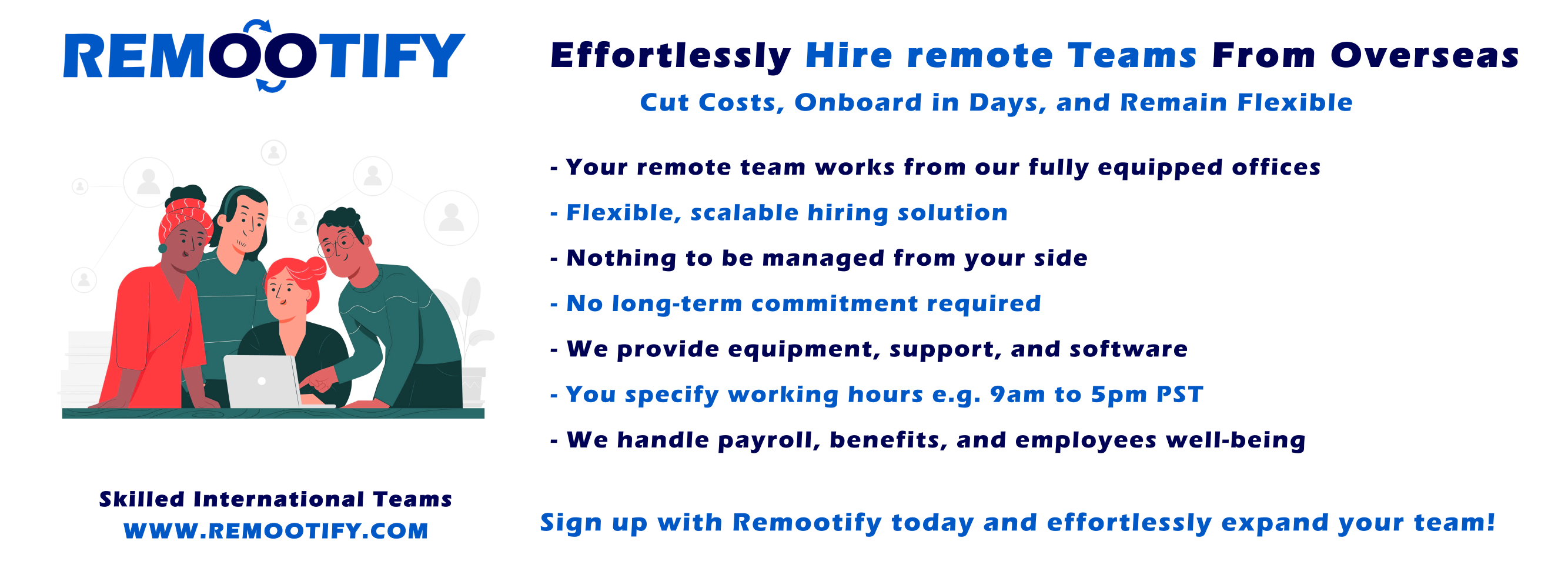Start hiring YOUR REMOTE TEAM, Today!
Enter your information below to start a discussion with one of our team members!

After the pandemic, remote work has gained immense popularity due to its flexibility and the potential for global talent acquisition.
However, nothing comes without its set of challenges, and remote work is no exception.
One of the primary challenges remote managers struggle with is managing time zone differences.
If you’re facing the same issue, fear not. This article will provide you with solutions to transform time zone differences from being a challenge into a benefit.
1. Time Zone Challenges for Remote Managers
Time zone differences create logistical challenges for remote project managers in terms of communication, collaboration, scheduling, and maintaining a cohesive and productive team environment.
Coordination: Remote managers need to coordinate with team members across various time zones, making it difficult to find overlapping working hours.
Communication Delay: Time zone differences can lead to significant communication delays, as messages and responses might be delayed by several hours or even a full day.
Scheduling Meetings: Finding suitable times for meetings that accommodate all team members’ time zones can be a complex task, potentially leading to inconvenient meeting times for some.
Real-time Collaboration: Remote managers often rely on real-time collaboration tools, and time zone differences can hinder the ability to work together in real-time, impacting project progress.
Response Time: Remote managers might experience longer response times from team members due to their working hours not aligning, potentially slowing down decision-making and problem-solving.
Misalignment of Work Hours: The standard work hours of a remote manager might not align with those of their team members, making it challenging to provide timely feedback and guidance.
Cultural Considerations: Different time zones can also be associated with different cultural norms and holidays, which remote managers need to be aware of to avoid misunderstandings or work disruptions.
Work-Life Balance: Time zone differences can blur the boundaries between work and personal life, as team members might receive work-related communication during their non-working hours.
Isolation: Remote managers might feel isolated or disconnected from their team members due to the lack of real-time interaction caused by time zone variations.
Impact on Decision-Making: Important decisions might need to be delayed until all team members’ input is received, potentially slowing down projects and initiatives.
2. Common Pitfalls: Mistakes Remote Managers Make in Handling Time Zone Differences
Ignoring Time Zone Differences: Some remote managers may underestimate the impact of time zone variations and fail to acknowledge the challenges they pose.
Setting Unrealistic Expectations: Remote managers might unintentionally set expectations for immediate responses or work progress, not accounting for delays caused by time zone differences.
Favoring Specific Time Zones: Giving preference to the time zone of the remote manager or a particular team member can lead to inequitable distribution of workload and communication challenges.
Poor Communication Planning: Failing to establish clear communication protocols that address time zone differences can result in missed messages, misalignment, and frustration.
Overloading Synchronous Communication: Relying heavily on real-time communication methods can exhaust team members in different time zones and disrupt their work-life balance.
Inflexible Meeting Schedules: Remote managers who rigidly schedule meetings during their own working hours without considering others’ availability can exclude some team members.
Neglecting Team Building: Not making intentional efforts to foster team cohesion across time zones can lead to isolation and reduced collaboration.
Ignoring Cultural Sensitivity: Neglecting cultural holidays, norms, and sensitivities can lead to misunderstandings and strained relationships among remote team members.
Micromanagement Due to Lack of Trust: Remote managers might resort to micromanagement because of perceived control issues arising from time zone differences and lack of immediate visibility into work.
Not Providing Flexibility: Remote managers who don’t offer flexibility in work hours to accommodate various time zones can hinder productivity and morale.
Lack of Documentation: Failing to document important decisions and discussions can hinder team members in different time zones from catching up and staying informed.
3. The Advantages of Embracing Time Zone Differences in Remote Work
24-Hour Productivity: Embracing time zone differences allows for continuous work progress as team members can contribute during their respective local working hours, leading to enhanced productivity.
Global Expertise: Having team members in different time zones brings diverse perspectives and expertise, enabling a more comprehensive approach to problem-solving and innovation.
Faster Project Turnaround: With round-the-clock work cycles, projects can move forward at a faster pace as tasks are handed off between team members in different time zones.
Enhanced Client Coverage: Teams spanning various time zones can provide better coverage to clients or customers around the world, improving client satisfaction and business opportunities.
Expanded Flexibility: Embracing time zone differences encourages flexibility in work hours, empowering team members to find a schedule that suits their productivity peaks and personal obligations.
Skillful Delegation: Delegating tasks across time zones showcases a manager’s ability to trust team members and delegate effectively, which can foster a positive work culture.
Seamless Collaboration: Combining synchronous and asynchronous communication methods ensures that collaboration remains continuous, regardless of the differences in team members’ working hours.
Enhanced Problem-Solving: Different time zones enable “fresh eyes” on challenges, enabling the team to approach problems from various angles and arrive at innovative solutions.
Cultural Sensitivity: Embracing time zone differences necessitates cultural awareness and sensitivity, fostering cross-cultural understanding and respect within the team.
Improved Work-Life Balance: Embracing time zone differences can lead to a healthier work-life balance, as team members have the flexibility to align their work with their personal lives.
4. Comparing the Impact of Time Zone Management
| Aspect | Remote Work with Time Zone Management | Remote Work without Time Zone Management |
|---|---|---|
| Communication | 🟢 Effective communication across time zones is prioritized. | 🔴 Communication challenges due to time differences may arise. |
| Scheduling | 🟢 Flexible scheduling accommodates various time zones | 🔴 Fixed schedules might lead to inconvenience for some employees. |
| Coordination | 🟢 Teams coordinate seamlessly despite geographic spread. | 🔴 Coordinating tasks can be difficult, leading to delays. |
| Global Collaboration | 🟢 Global teams collaborate efficiently with overlapping hours. | 🔴 Collaborative opportunities are limited, affecting innovation. |
| Employee Satisfaction | 🟢 Employees feel valued as their needs are considered. | 🔴 Employees might feel overlooked due to time zone disparities. |
5. Efficient Time Zone Management Strategies for Remote Collaboration
Adopt a Time Zone-Aware Communication Approach
- Encourage team members to clearly specify their local time zones in their communication profiles.
- Use time zone conversion tools or applications to display meeting times in the local time of all participants.
- Set expectations for response times that consider the time zones of team members.
Implement Flexible Scheduling
- Foster a culture of flexibility by allowing team members to adjust their work hours within reasonable boundaries.
- Establish core working hours where all team members are expected to be available for synchronous communication.
- Distribute work tasks in a way that takes advantage of overlapping working hours for collaborative tasks.
Identify Key Time Overlaps
- Determine the specific hours during which there is a significant overlap between the working hours of team members in different time zones.
- Pinpoint these time windows for essential tasks that require synchronous collaboration.
Utilize Asynchronous Communication and Workflows
- Encourage the use of asynchronous communication channels, such as email, project management tools, and messaging apps, to minimize real-time dependencies.
- Implement shared documentation platforms to provide visibility into ongoing tasks and projects, reducing the need for immediate responses.
Designate Time Zone Liaisons
- Appoint individuals from different time zones as liaisons to bridge communication gaps and facilitate coordination.
- Liaisons can ensure that information is properly relayed and decisions are communicated to team members who might be offline during critical discussions.
Rotate Meeting Times for Fairness
- Rotate the timing of regular team meetings or important discussions to ensure that no particular time zone consistently bears the burden of inconvenient meeting times.
- Document meeting outcomes and share recordings or summaries to keep all team members informed.
Promote Cross-Functional Collaboration
- Structure teams to include members from different time zones when feasible, promoting a natural distribution of work hours for cross-functional tasks.
- Encourage team members to proactively reach out to colleagues in other time zones for collaboration and support.
Invest in Time Zone Awareness Training
- Educate team members about the challenges and benefits of working across time zones.
- Provide resources and training on effective time zone management, including tools and techniques for managing work in a global context.
Use Time Zone Overlays in Project Management Tools
- Integrate time zone overlays in project management tools, calendars, and scheduling software to visualize the working hours of team members across different regions.
- This helps in scheduling tasks, setting deadlines, and avoiding conflicts due to time zone differences.
Encourage Empathy and Respect
- Foster an atmosphere of understanding by reminding team members to be considerate of each other’s working hours and personal lives.
- Emphasize the value of accommodating diverse time zones to build a collaborative and inclusive remote work environment.
Regularly Evaluate and Adjust Strategies
- Continuously gather feedback from team members regarding the effectiveness of time zone management strategies.
- Be open to adjusting approaches based on the evolving needs and challenges faced by the team.
Communication’s Vital Role in Overcoming Time Zone Differences
- Facilitates coordination across different time zones.
- Prevents misunderstandings and missed meetings.
- Enables timely decision-making and problem-solving.
- Supports seamless task handoffs and progress updates.
- Fosters an inclusive and collaborative team environment.
- Builds trust and relationships among remote team members.
- Provides transparency in project updates and status.
- Helps manage expectations for response times.
- Enhances overall productivity and project outcomes.
6. Essential Time Zone Management Tools for Seamless Global Collaboration
World Clocks
- Timeanddate.com: Provides an online world clock showing multiple time zones.
- Windows World Clock Widget: A widget that displays multiple time zones on the Windows desktop.
Time Zone Converters
- World Time Buddy: Offers a user-friendly interface to convert and compare times.
- Every Time Zone: Provides a simple way to visualize time overlaps and conversions.
Calendar Apps
- Google Calendar: Allows scheduling events in different time zones.
- Microsoft Outlook: Offers time zone support for scheduling meetings and appointments.
Communication Platforms
- Slack: Integrates time zone conversions in messages and notifications.
- Microsoft Teams: Displays meeting times in different time zones.
Project Management Software
- Trello: Offers power-ups that show due dates in various time zones.
- Asana: Allows setting due dates and milestones with time zone awareness.
Meeting Scheduler Apps
- Doodle: Helps find suitable meeting times across multiple time zones.
- World Time Buddy Meeting Scheduler: Integrates with popular scheduling apps.
Time Zone Overlays
- Clocker: A Mac app that displays time zone overlays on the menu bar.
- Qlock World Clock: A Windows app with customizable time zone overlays.
Global Meeting Planners
- World Time Server Meeting Planner: Helps coordinate meetings across various time zones.
- Time Zone Meeting Planner by Timeanddate.com: Provides an easy way to schedule meetings internationally.
Video Conferencing Software
- Zoom: Allows scheduling meetings that display times in different time zones.
- Microsoft Teams: Offers integrated time zone support for meeting scheduling.
Task Management Apps
- ClickUp: Supports time zone-aware task assignments and due dates.
- Todoist: Allows setting deadlines with time zone considerations.
7. How Remote Work Service Providers Facilitate Effective Time Zone Management?
Remote work service providers can significantly enhance an organization’s ability to effectively manage time zone differences, ensuring efficient communication, collaboration, and productivity across a global workforce.
Global Talent Pool: Access to a diverse range of candidates from various time zones, making it easier to assemble teams with complementary work hours.
Time Zone Expertise: Providers offer insights on structuring work hours, scheduling meetings, and coordinating tasks to accommodate different time zones.
Candidate Vetting: They assist in identifying candidates who are accustomed to remote work and capable of effectively managing time zone challenges.
Cross-Cultural Sensitivity: Providers offer cultural awareness training, fostering understanding and effective communication among team members from different regions.
Efficient Scheduling: They help set up work schedules that maximize overlapping hours for collaborative tasks and minimize delays.
Global Communication Tools: Providers suggest and implement communication tools that facilitate real-time and asynchronous collaboration across time zones.
24/7 Support: With teams distributed across the globe, service providers can offer round-the-clock support for technical and operational issues.
Time Zone Liaisons: Designate time zone liaisons who bridge communication gaps between different regions, ensuring smooth information flow.
Customized Workflows: They create workflows that consider time zone differences, ensuring tasks move seamlessly across different stages, even when team members are offline.
Meeting Optimization: Providers help plan and schedule meetings to ensure participation from all time zones and minimize inconveniences.
Performance Tracking: Implement systems for tracking work progress and deliverables, accounting for time zone variations.
Onboarding and Training: Providers assist in onboarding remote employees, educating them about time zone management best practices.
Cross-Functional Collaboration: Facilitate collaboration between team members in different regions for cross-functional projects by optimizing work hours.
Emergency Coverage: Arrange backup coverage to ensure critical tasks are handled, even if a team member from a particular time zone is unavailable.
Crisis Management: In times of crisis or urgent situations, remote work service providers help coordinate responses across various time zones.
Performance Analytics: They provide insights into team performance, identifying potential time zone-related challenges and suggesting improvements.
Legal and Compliance: Address legal, tax, and compliance issues associated with employing remote workers across different jurisdictions.
Feedback and Improvement: Regularly gather feedback from team members to fine-tune time zone management strategies and adapt to changing needs.
—
Conclusion
Time zone differences emerged as a significant challenge for managers. However, effective management strategies can turn these challenges into opportunities, fostering global collaboration, 24-hour productivity, and diverse expertise.
Embracing time zone differences and employing thoughtful strategies will be crucial in building successful and cohesive remote teams.
—
FAQs
Why are time zone differences a challenge in remote work?
Time zone disparities complicate communication, scheduling, and collaboration among remote teams, posing obstacles to seamless interaction and coordination.
How can remote managers address time zone challenges?
Remote managers can use strategies like time zone-aware communication, flexible scheduling, identifying overlap hours, embracing asynchronous tools, and fostering cross-functional collaboration to overcome time zone hurdles effectively.
What are the benefits of embracing time zone differences?
Adopting time zone differences can lead to 24-hour productivity, global expertise, faster project completion, enhanced client coverage, and improved work-life balance, amplifying the strengths of remote teams.
What mistakes should remote managers avoid in time zone management?
Remote managers should steer clear of neglecting time zone impact, setting unrealistic expectations, favoring specific time zones, poor communication planning, excessive synchronous communication, and overlooking team building, cultural sensitivity, trust, flexibility, and documentation, to ensure successful remote team dynamics.
What tools can remote managers use to facilitate time zone management?
Remote managers can rely on tools like world clocks, time zone converters, calendar apps with time zone support, communication platforms displaying multiple time zones, project management software with overlays, meeting schedulers, and video conferencing tools to streamline collaboration and scheduling across different time zones.





